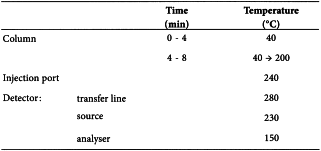Appendix VIII V. Methanesulfonyl Chloride in Methanesulfonic Acid
The following method has been validated for the determination of methanesulfonyl chloride in methanesulfonic acid at concentrations in the range of 0.05 ppm to 50 ppm.
Gas chromatography (2.2.28) coupled with mass spectrometry (2.2.43).
Internal standard solution Dissolve 7 µL of butyl methanesulfonate CRS (BMS) in methylene chloride R and dilute to 10.0 mL with the same solvent. Dilute 5.0 mL of this solution to 50.0 mL with methylene chloride R.
Test solution To 5 mL of water R, add 7.4 g of the substance to be examined and mix slowly. After cooling, add 5.0 mL of methylene chloride R and 100 µL of the internal standard solution and shake. Allow to separate and transfer the organic layer to a vial containing 1 g of anhydrous sodium sulfate R. Repeat the extraction twice with 5.0 mL of methylene chloride R each time, combine the organic layers and filter.
Reference solution (a) Dissolve 50.0 mg of methanesulfonyl chloride R in methylene chloride R and dilute to 10.0 mL with the same solvent. Dilute 1.0 mL of the solution to 10.0 mL with methylene chloride R. Dilute 300 µL of this solution to 10.0 mL with methylene chloride R.
Reference solution (b) Dilute 500 µL of reference solution (a) and 100 µL of the internal standard solution to 15.0 mL with methylene chloride R.
Reference solution (c) Dilute 25 µL of reference solution (a) and 100 µL of the internal standard solution to 15.0 mL with methylene chloride R.
Carrier gas helium for chromatography R.
Flow rate 1 mL/min.
Pulsed splitless 60 kPa, 0.1 min.
At the end of analysis the temperature of the column is raised to 270 °C and maintained at this temperature for 8 min.
Detection Mass spectrometer as described below; adjust the detector settings so as to comply with the system suitability criteria:
Injection 5 µL of the test solution, reference solutions (b) and (c), the internal standard solution and methylene chloride R.
Relative retention With reference to the internal standard (BMS) (retention time = about 7.2 min): methanesulfonyl chloride = about 0.68.
Calculate the content of methanesulfonyl chloride in parts per million using the following expression:
| A1 | = | area of the peak due to methanesulfonyl chloride in the chromatogram obtained with reference solution (b); |
| A2 | = | area of the peak due to methanesulfonyl chloride in the chromatogram obtained with the test solution; |
| C | = | percentage content of methanesulfonyl chloride; |
| I1 | = | area of the peak due to BMS in the chromatogram obtained with reference solution (b); |
| I2 | = | area of the peak due to BMS in the chromatogram obtained with the test solution; |
| W1 | = | mass of methanesulfonyl chloride used to prepare reference solution (a), in milligrams; |
| W2 | = | mass of the sample in the test solution, in milligrams; |
| 1.5 | = | dilution factor. |


